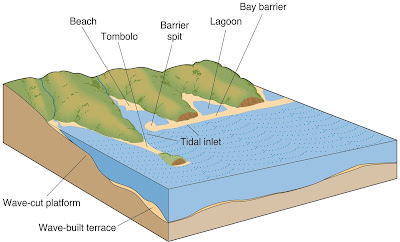The Harbors of Monaco, from Travel World website
Ten years would not change much of the landscape of Monaco. The
convergence of the Eurasian plate and the African plate may cause the mountain
in which Monaco is located at the foothills of, Mont Agel, to rise slightly. The faults along the mountainside will continue to crack and
expand; creating more joints and fractures. The tafoni along the walls of the
cliffs would expand due to salt weathering, and the
cliffs of the Rock of Monaco would erode slightly more since it is not
protected by anything. Overall, ten years would not yield much change in the coastal
landscape.
100 years of weathering, erosion and plate convergence would take a toll
on the landscape of Monaco. The rock of Monaco will definitely have continued
to erode more severely. As salt weathering and other elements of weather decay the
cliffs of The Rock of Monaco, the entire monolith will gradually become
smaller, causing society to move buildings further inland on the rock. Faults
and joints on Mont Agel will become much more severe, and faulting of the rocks
will cause pressure release shells to literally pop off the side of the mountain.
The landscape would be much different in 1000 years. The most prominent change would be The Rock of Monaco. The monolith is exposed and vulnerable to weathering and elements. The Rock's cliff's plunge into the Mediterranean Sea, and 1000 years of weathering would erode and almost deplete the monolith. Society would be forced off the rock, and the Rock of Monaco could eventually become tombolo. Converging plate tectonics take a toll on Mont Agel, causing it's peak to rise higher than before, or the joints and fractures be so severe that the foothills would be almost unrecognizable. The most obvious way to recognize change in the landscape will be to see how the city and people of Monaco will have been forced to change.
Humans have packed buildings and city structures into the coastal landscape. When you look past the buildings, roads, and harbors of Monaco, you can recognize the natural beauty of the landscape. The foothills of Mont Agel create a beautiful backdrop between France and Monaco, and the white beaches separate it from the Mediterranean Sea. It's mild climate makes a fairly ideal place to live, if you can afford it. The Rock of Monaco makes for great sight-seeing, as it overlooks the sea and its views are not obstructed by other landforms. If you plan on visiting Monaco, make sure it's within the next 1000 years, so you can appreciate the landscape the way it is today before it changes!
An example of pressure release shells.
The landscape would be much different in 1000 years. The most prominent change would be The Rock of Monaco. The monolith is exposed and vulnerable to weathering and elements. The Rock's cliff's plunge into the Mediterranean Sea, and 1000 years of weathering would erode and almost deplete the monolith. Society would be forced off the rock, and the Rock of Monaco could eventually become tombolo. Converging plate tectonics take a toll on Mont Agel, causing it's peak to rise higher than before, or the joints and fractures be so severe that the foothills would be almost unrecognizable. The most obvious way to recognize change in the landscape will be to see how the city and people of Monaco will have been forced to change.
The photo shows an example of a tombolo. Thanks to Dr. Casey Allen's website.
Humans have packed buildings and city structures into the coastal landscape. When you look past the buildings, roads, and harbors of Monaco, you can recognize the natural beauty of the landscape. The foothills of Mont Agel create a beautiful backdrop between France and Monaco, and the white beaches separate it from the Mediterranean Sea. It's mild climate makes a fairly ideal place to live, if you can afford it. The Rock of Monaco makes for great sight-seeing, as it overlooks the sea and its views are not obstructed by other landforms. If you plan on visiting Monaco, make sure it's within the next 1000 years, so you can appreciate the landscape the way it is today before it changes!
From In Spirit Magazine



